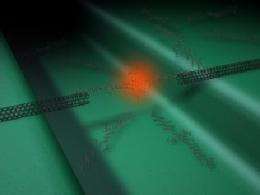December 20, 2010 feature
'Molecular torch' between carbon nanotubes emits electroluminescence

(PhysOrg.com) -- A single molecule bridging a "broken" single-walled carbon nanotube (CNT) is barely visible through a powerful scanning electron microscope, but the precisely assembled system can act as a functional solid-state electronics device. These CNT-molecule-CNT junctions have been developed only in the past few years, and measuring their optical characteristics has been a difficult task. In a new study, scientists have observed for the first time that the molecule between the nanotubes can emit light due to an electric current passing through it, a phenomenon called electroluminescence.
In their study, scientists Christoph W. Marquardt from the Karlsruhe Institute of Technology in Karlsruhe, Germany, and coauthors from the University of Basel in Basel, Switzerland; the Poznan University of Economics in Poznan, Poland; and the DFG Center for Functional Nanostructures in Karlsruhe, Germany, have published their study in a recent issue of Nature Nanotechnology.
As the scientists explained, the carbon nanotubes contain a pair of metallic electrodes. Through electrical breakdown, the scientists could create a gap of just a few nanometers between the electrodes. The gap’s position and size of less than 10 nm had to be controlled with nanoscale precision in order to allow for a current. The researchers then assembled a molecule having a 6-nm-long rod-like structure and electrical characteristics that enabled it to be electrostatically trapped in the gap, completing the “circuit” between the electrodes. They predicted that the electrode gap could host no more than one to three of these molecules.
When applying a voltage to the electrodes, the scientists observed bright spots of electroluminescence, and they could control the electroluminescence by switching the voltage on and off. The scientists could determine that the light was coming from the molecule between the electrodes by overlaying an image captured previously with external illumination. The researchers observed a small bright spot between the electrodes in 6 of 20 CNT-molecule-CNT devices. They calculated that, on average, one photon was emitted per 1 billion electrons.
"This is the first time that electroluminescence has been observed from CNT-molecule-CNT junctions," coauthor Ralph Krupke from the Karlsruhe of Technology and DFG Center for Functional Nanostructures told PhysOrg.com. He noted that, in 2004, Dong, et al., observed electroluminescence from a molecule in a scanning tunneling microscope setup.
“In our view, the greatest significance is that we succeeded in forming a rigid solid-state device by integrating a bottom-up structure, the molecule, into a top-down structure, the CNT gap,” he said. “Thereby we had to control the critical dimensions and the molecule had to be tailored to enable light emission under voltage bias. Furthermore, from a molecular electronics point of view, it is the first time that the presence of the molecule in the gap is confirmed by its optical signature.”
Currently, the scientists are fabricating variations of this device by using different molecules that emit light at different wavelengths. The results of the study show that carbon nanotubes could have a variety of applications in molecular electronics.
"Molecular electronics aims at the fundamental understanding of charge transport through molecules and is motivated by the vision of molecular circuits to enable miniscule, powerful and energy-efficient computers,” Krupke said. “Our result is important for fundamental science but it also adds to the molecular electronics vision an optoelectronic component, i.e., the development of optoelectronic components on the basis of single molecules."
More information: Christoph W. Marquardt, Sergio Grunder, Alfred Błaszczyk, Simone Dehm, Frank Hennrich, Hilbert v. Löhneysen, Marcel Mayor, and Ralph Krupke. “Electroluminescence from a single nanotube-molecule-nanotube junction.” Nature Nanotechnology. Advance Online Publication. DOI: 10.1038/NNANO.2010.230
Copyright 2010 PhysOrg.com.
All rights reserved. This material may not be published, broadcast, rewritten or redistributed in whole or part without the express written permission of PhysOrg.com.

















